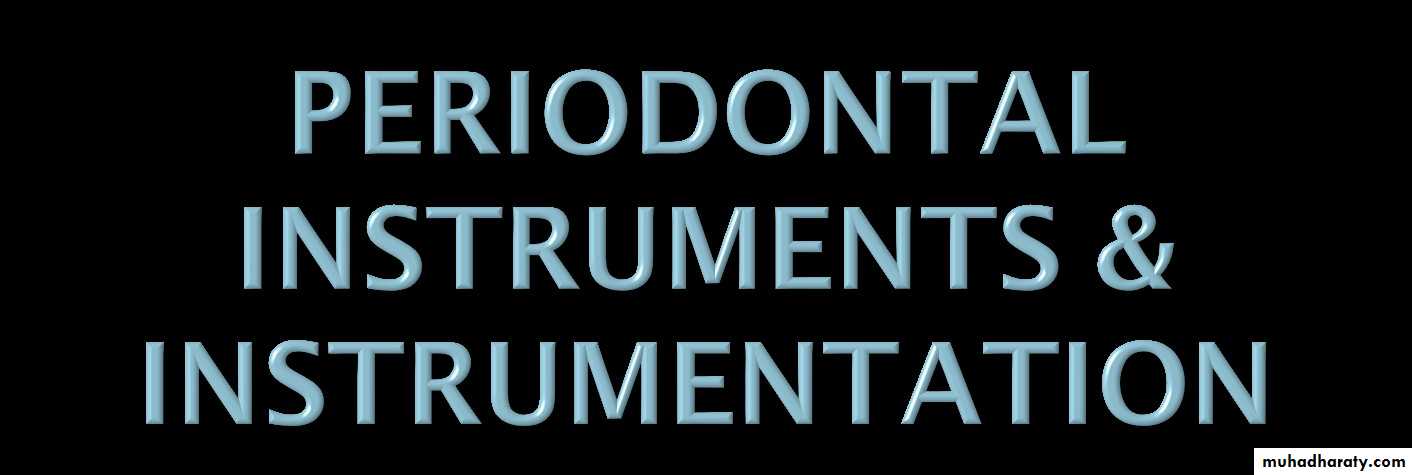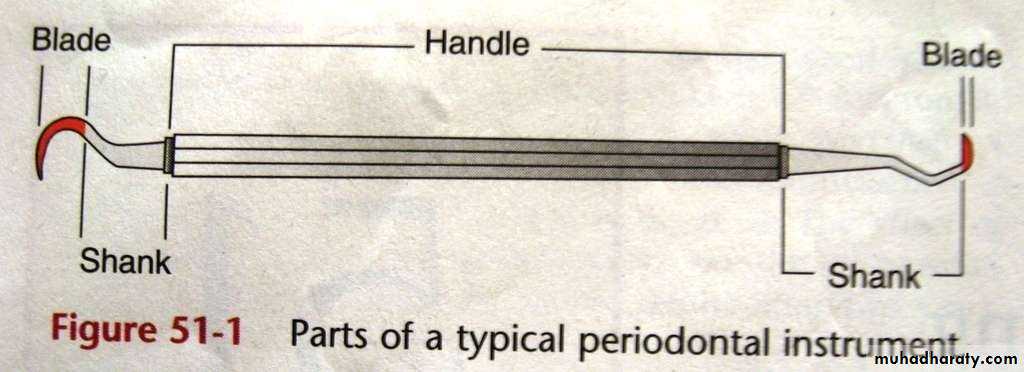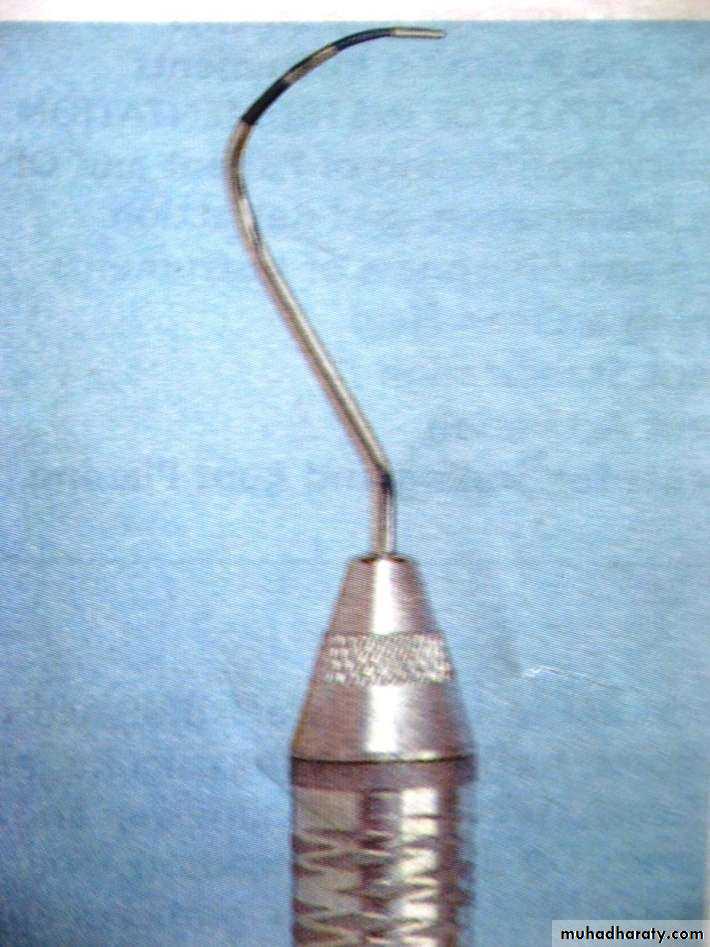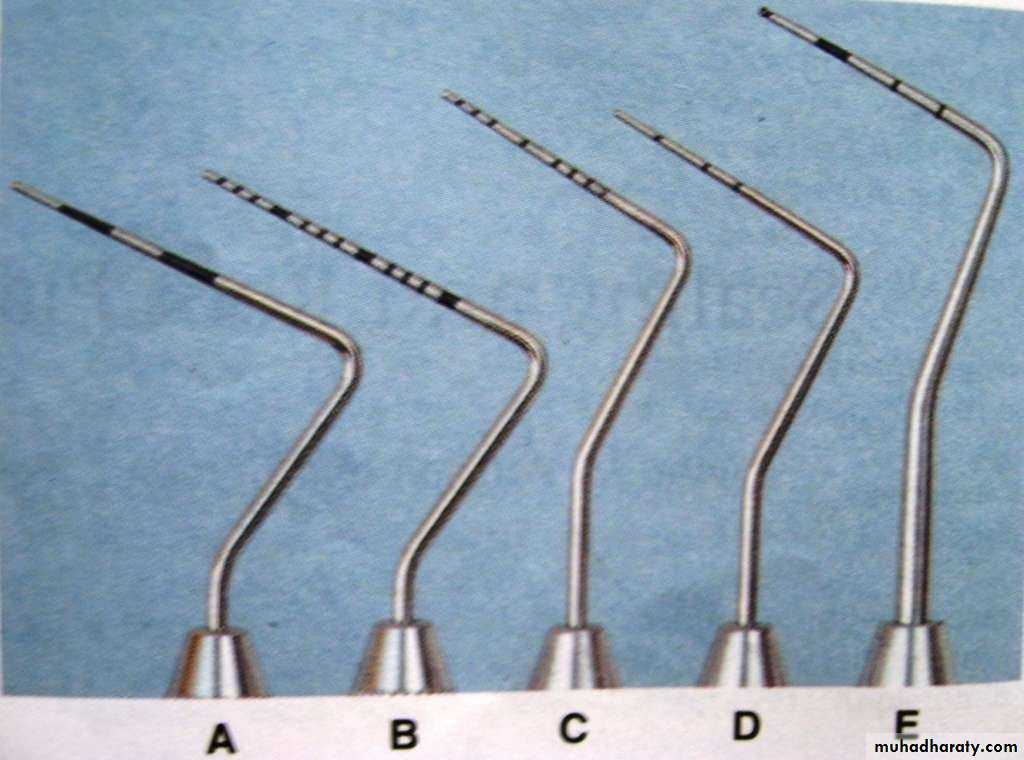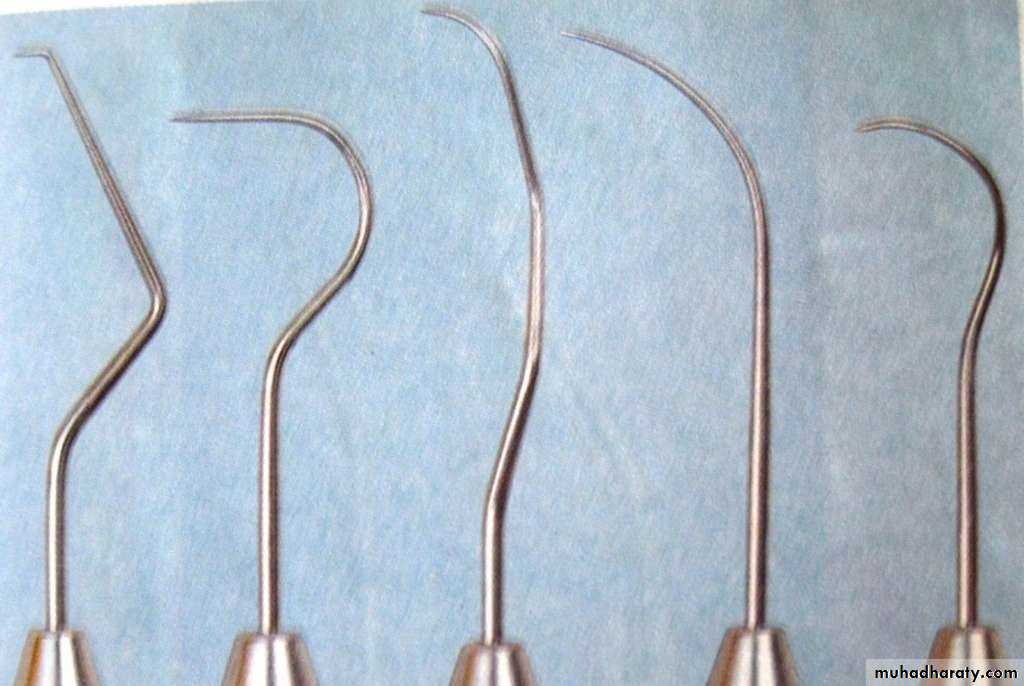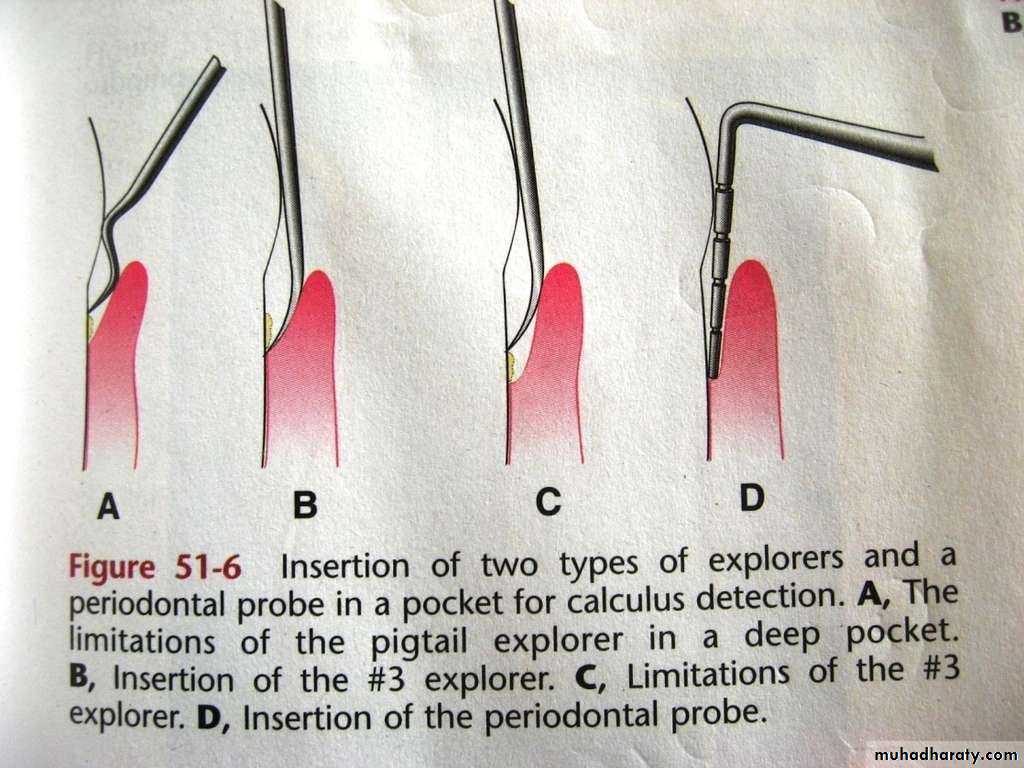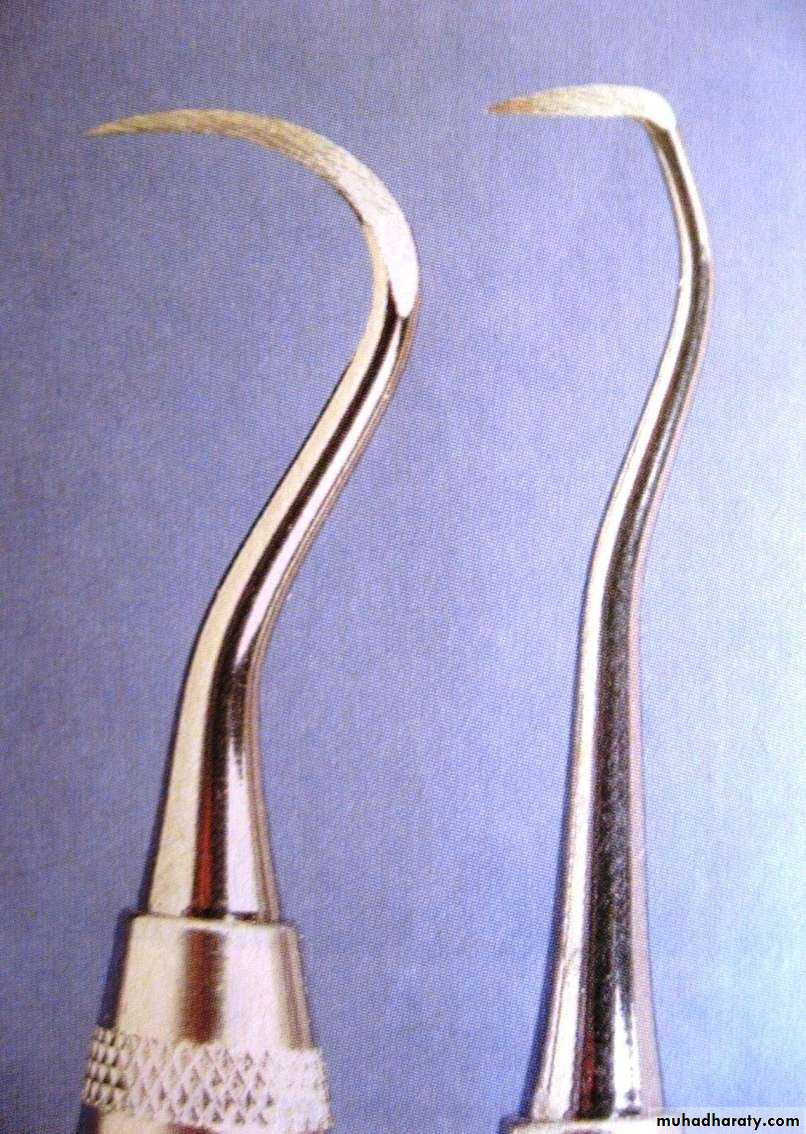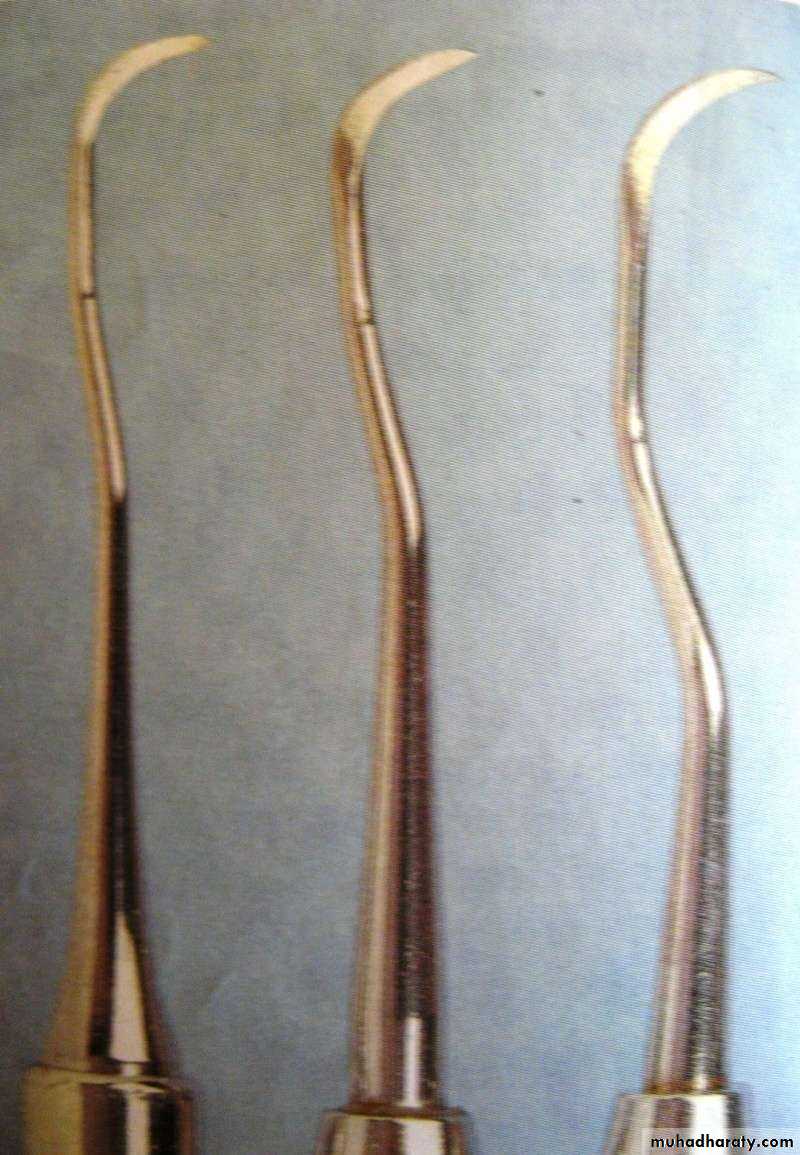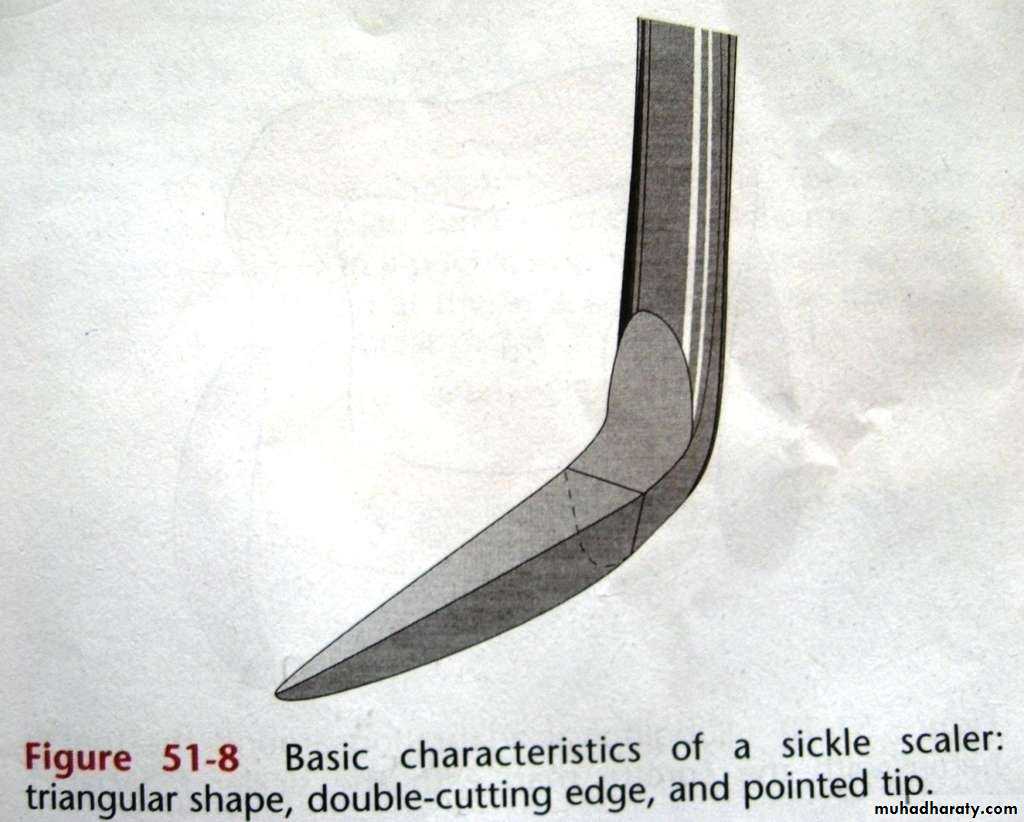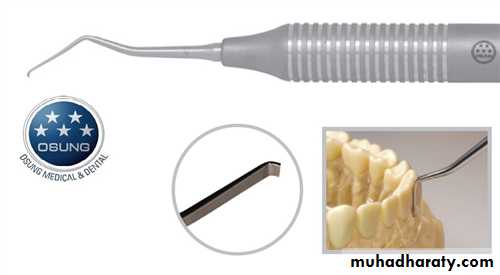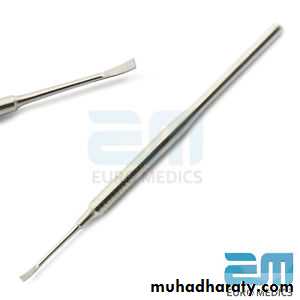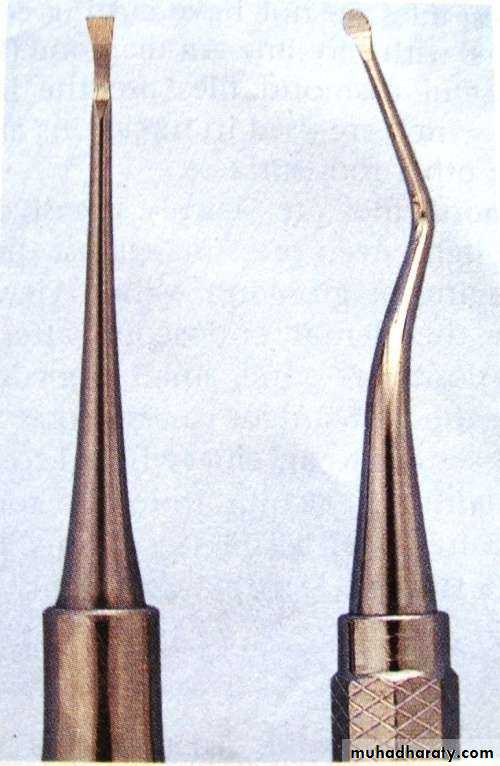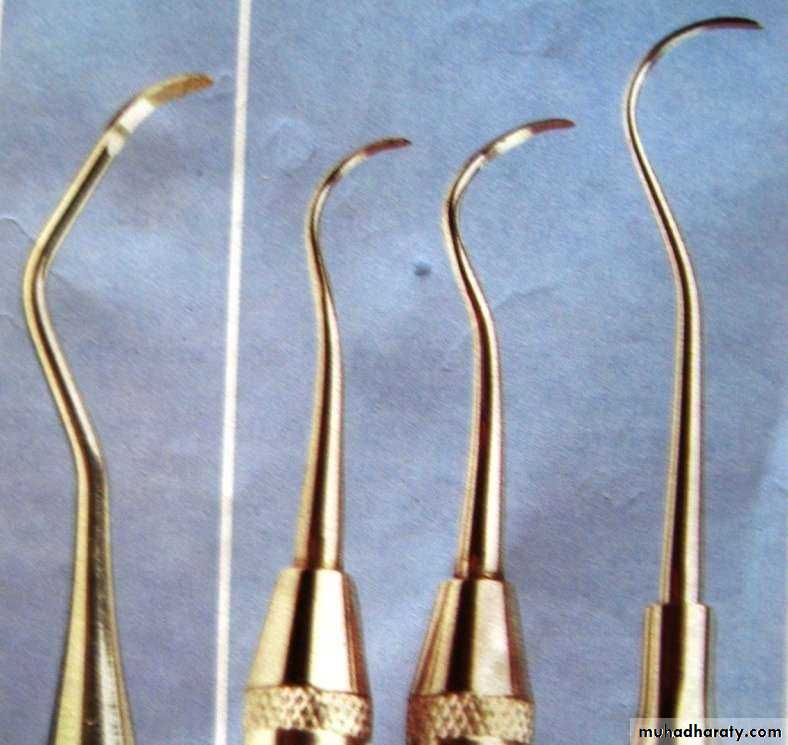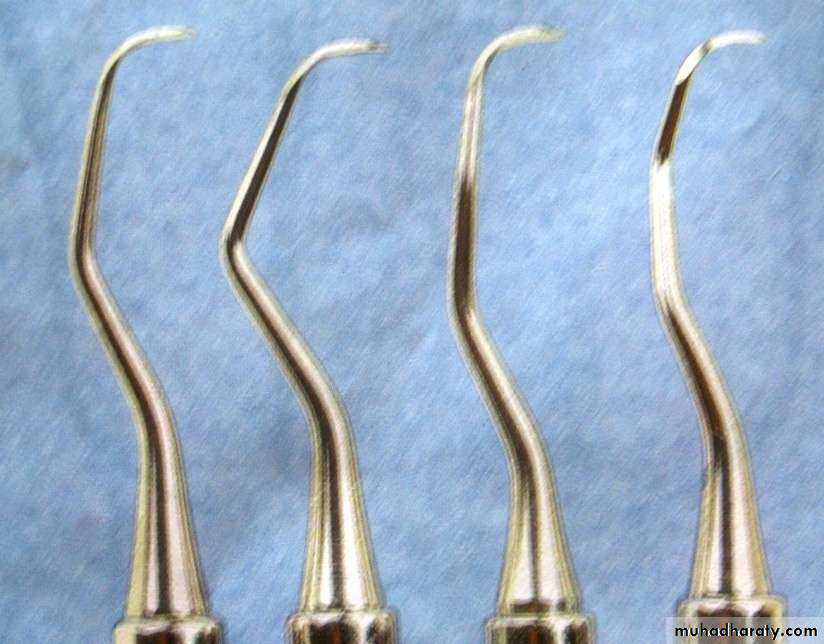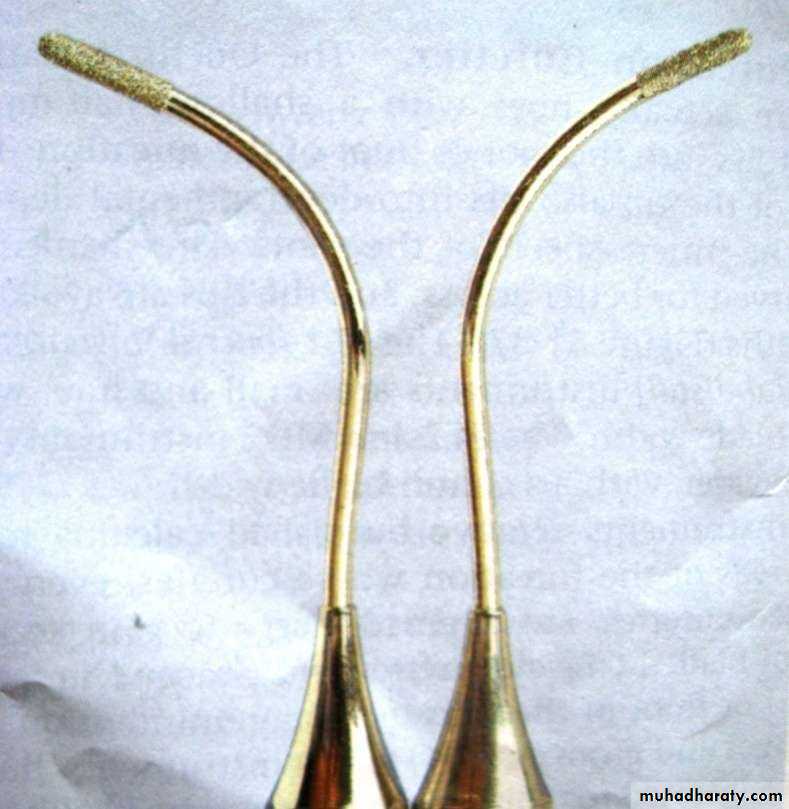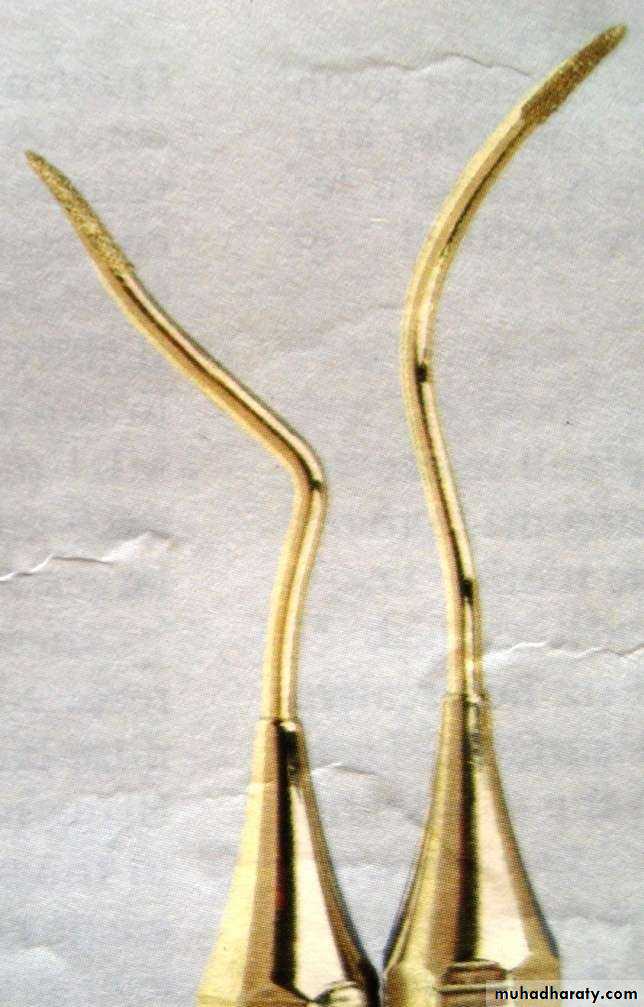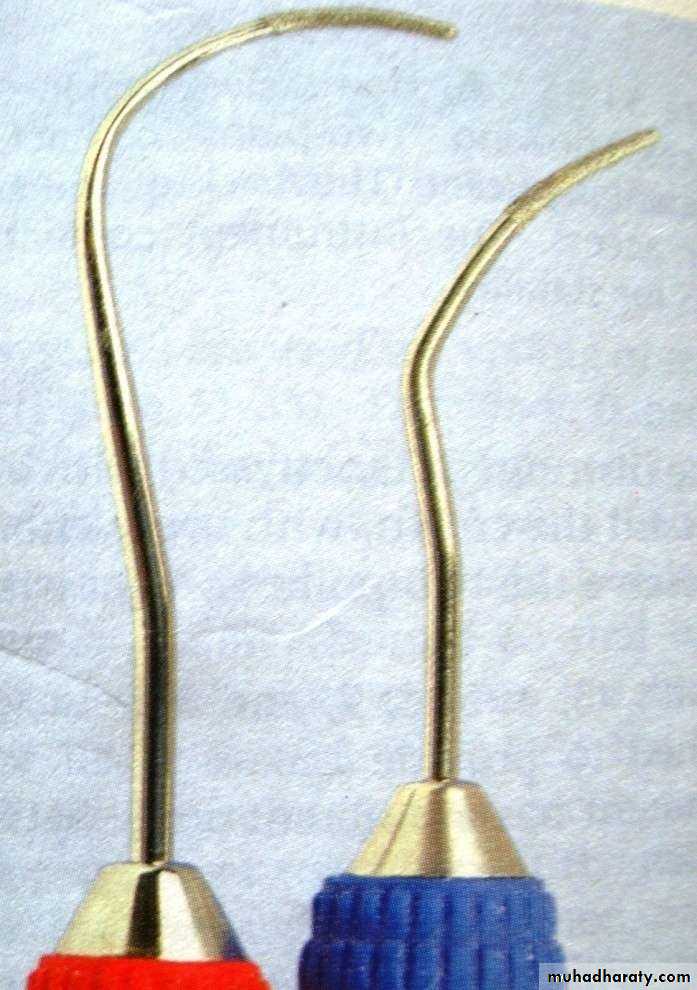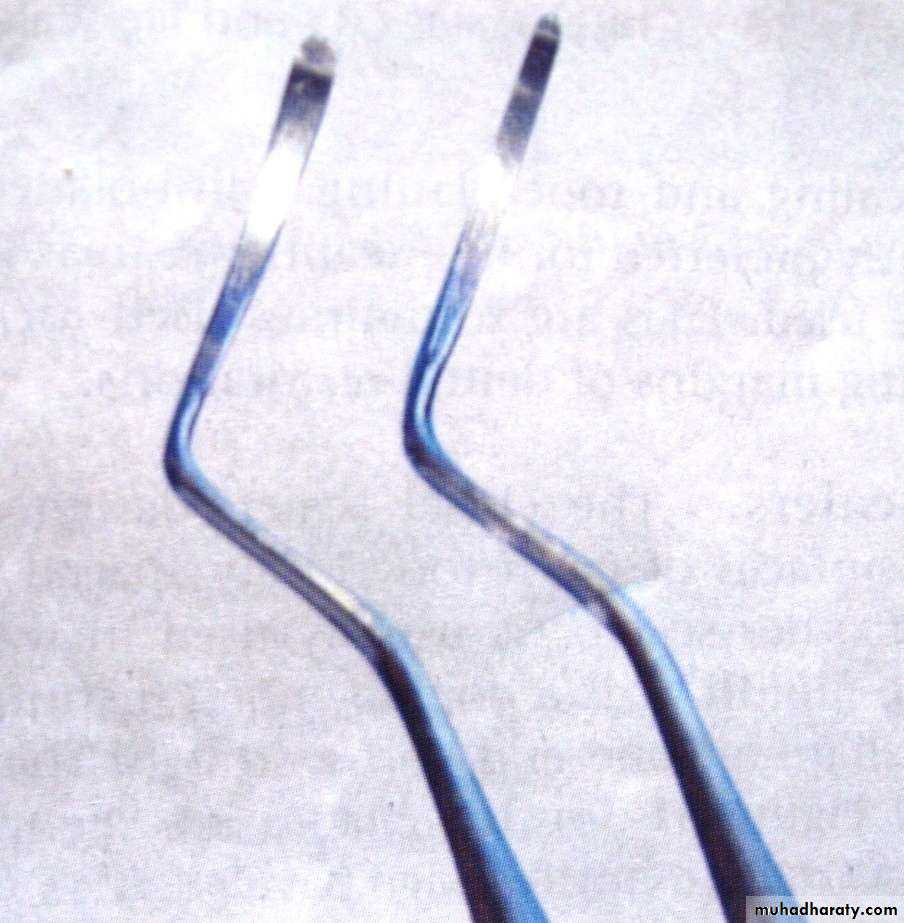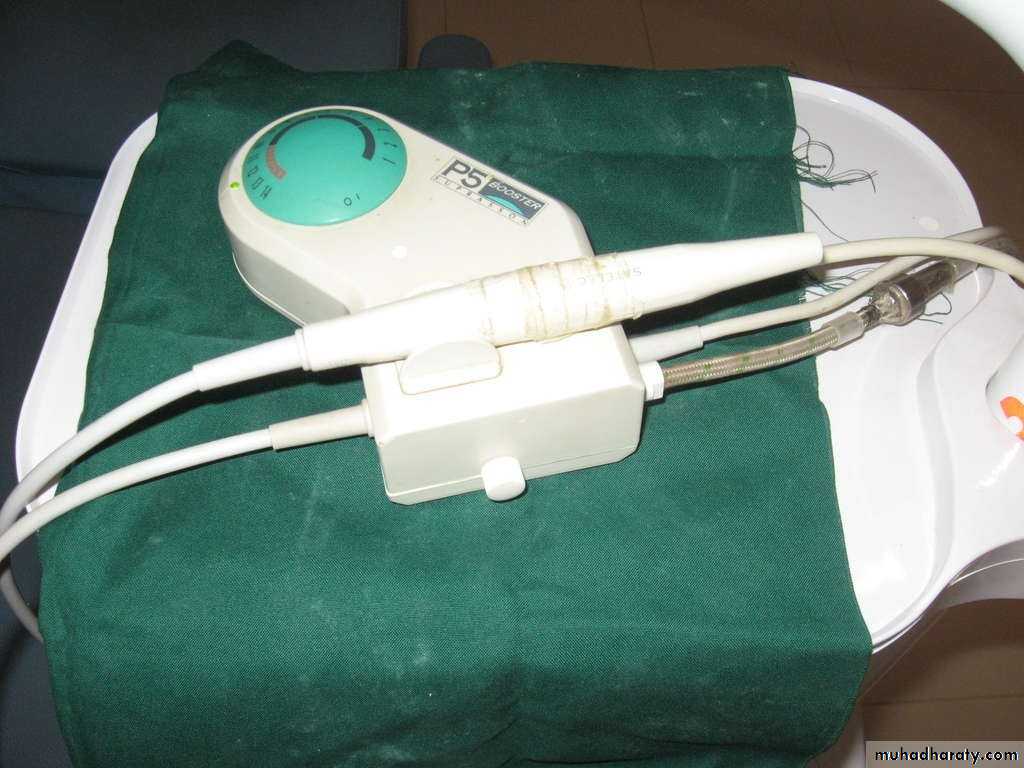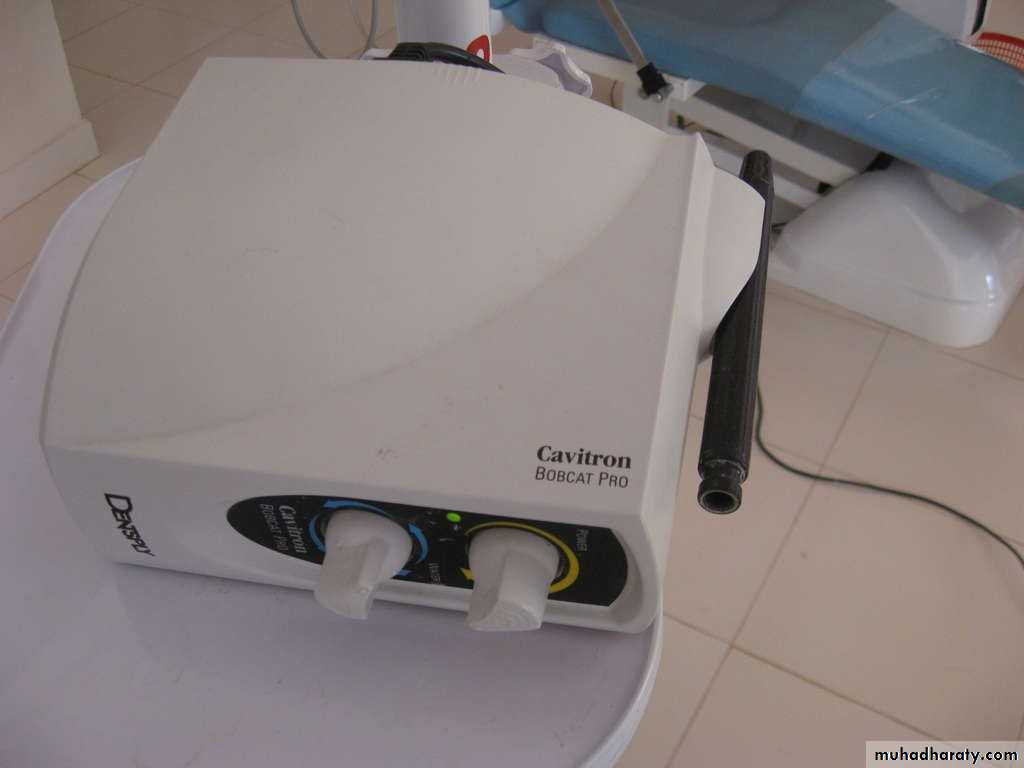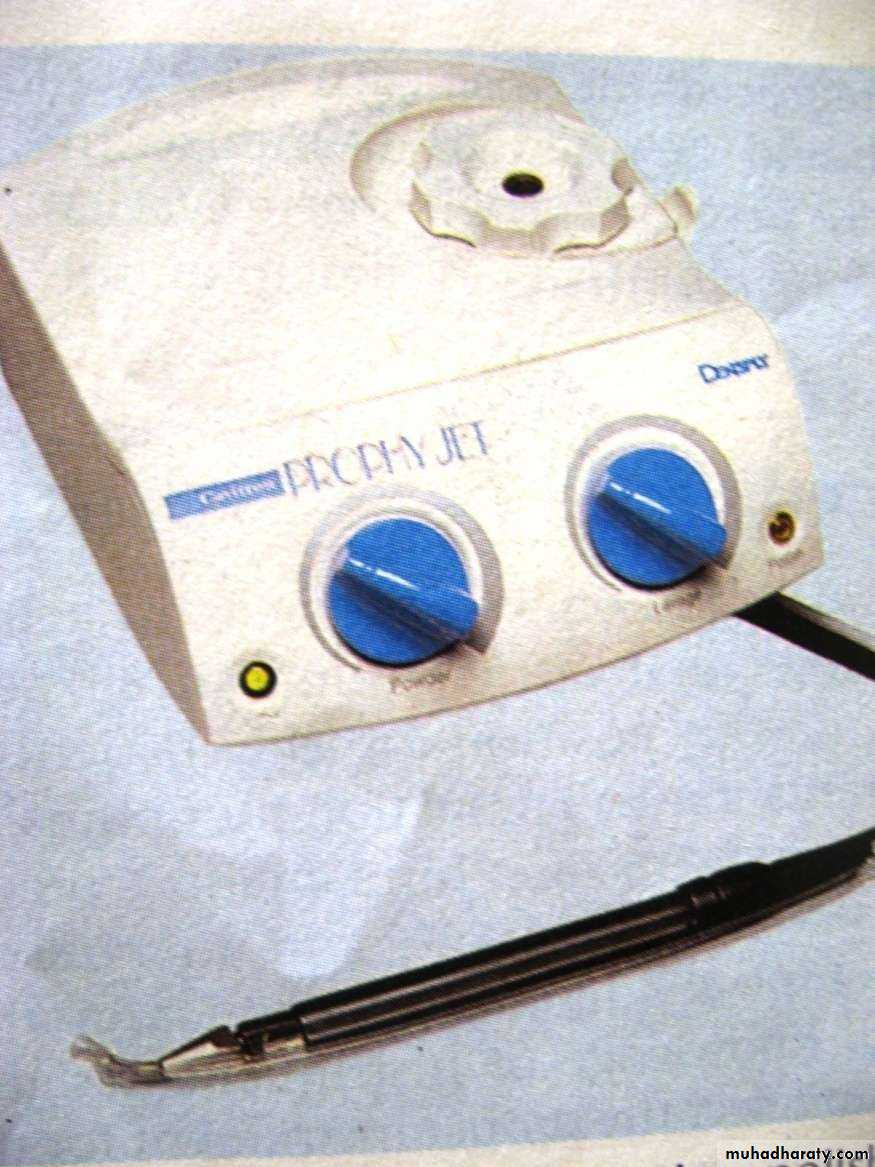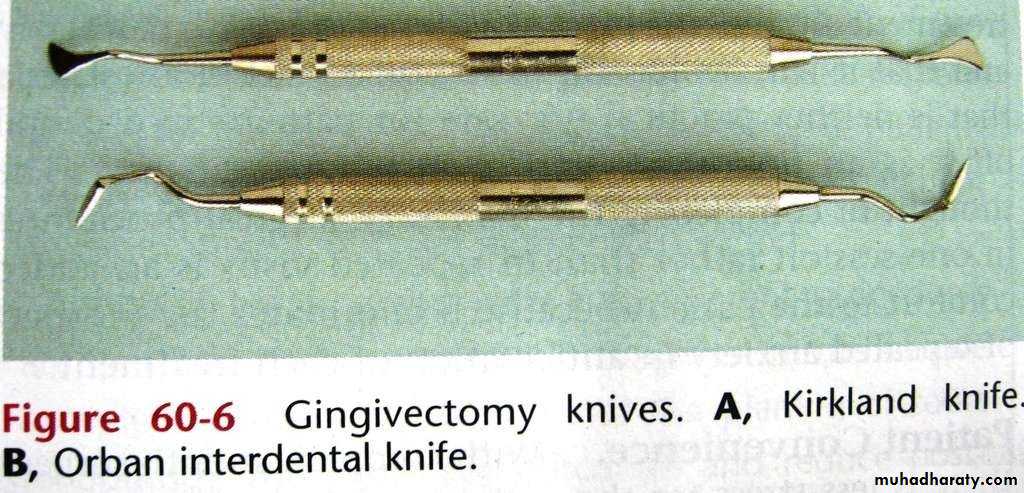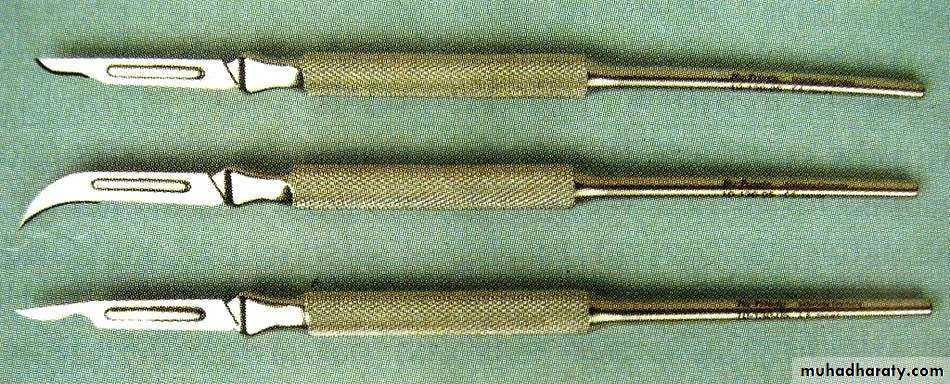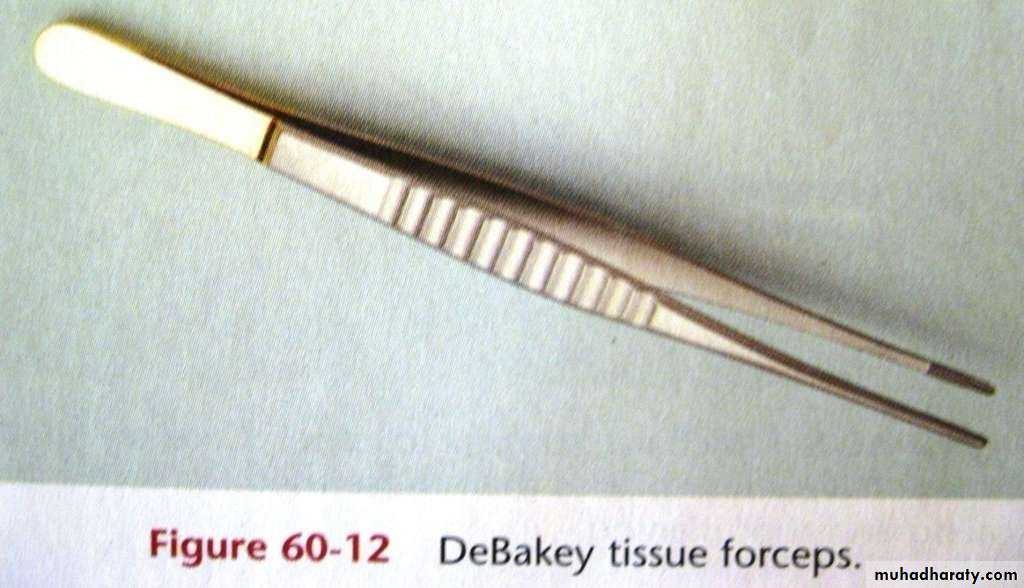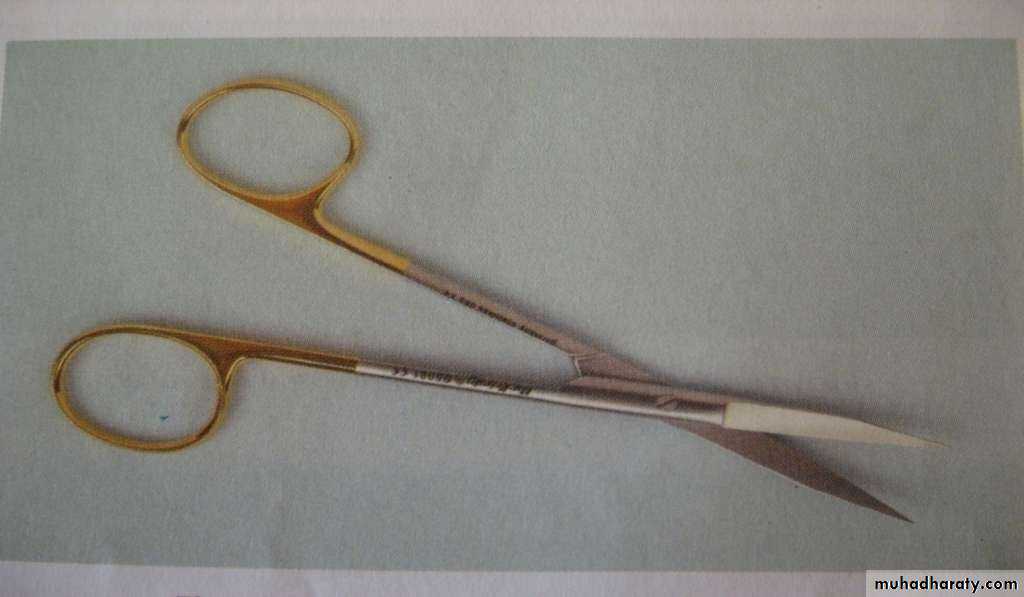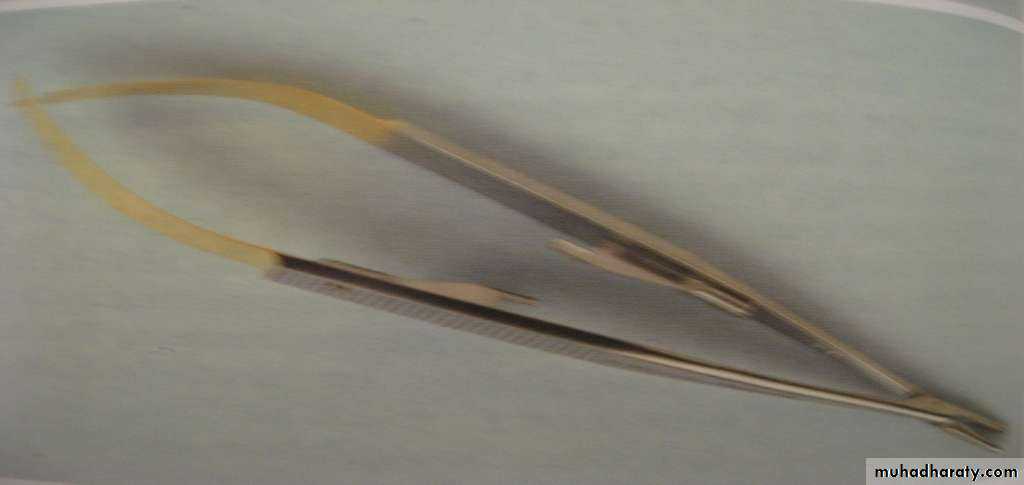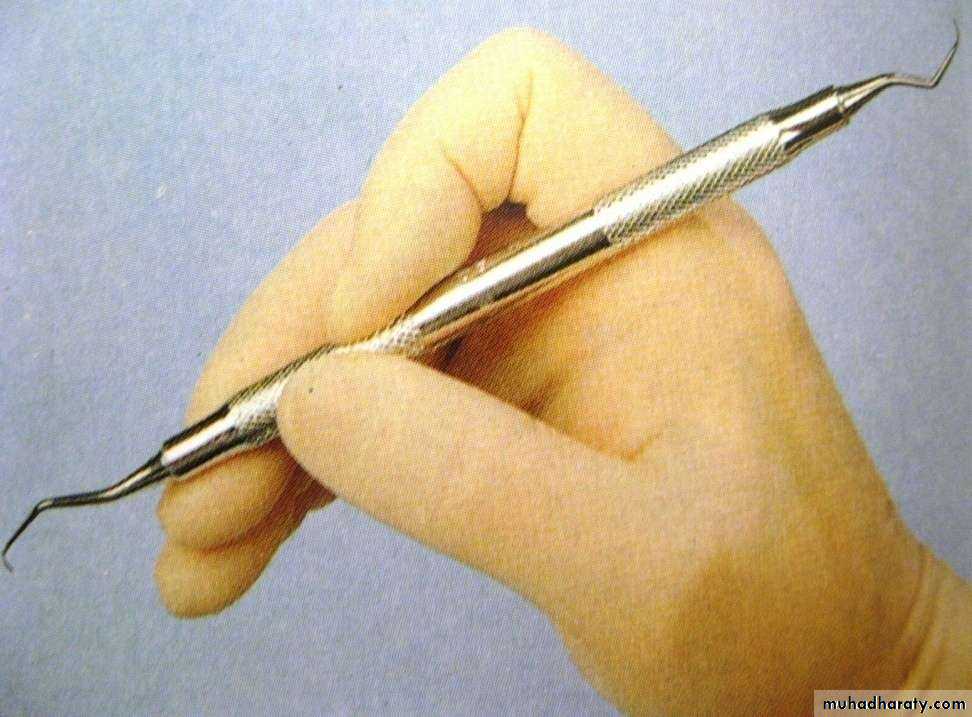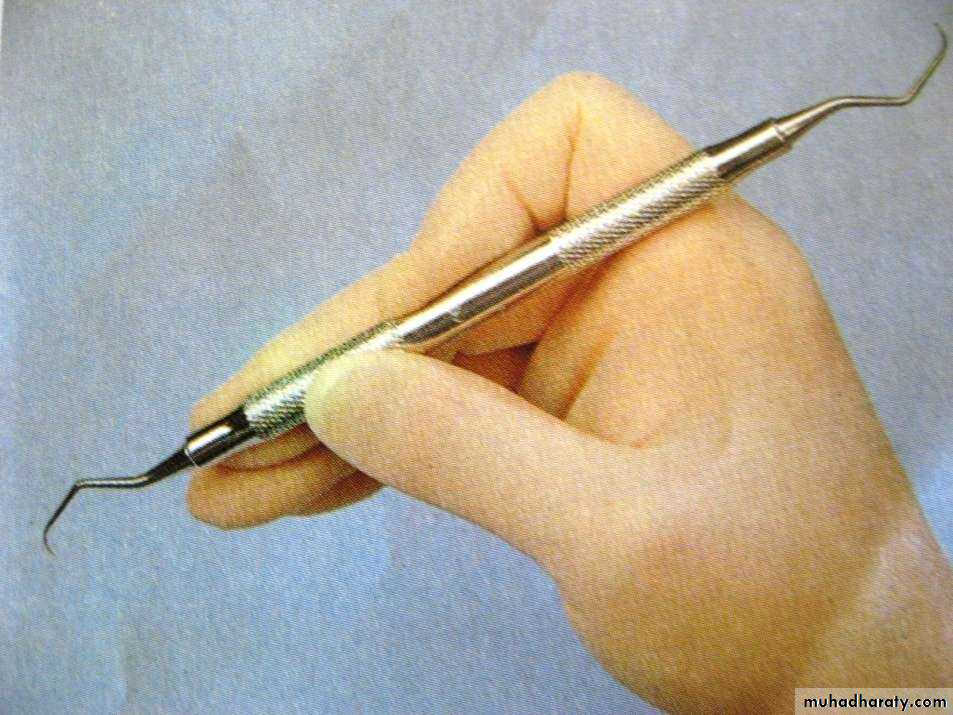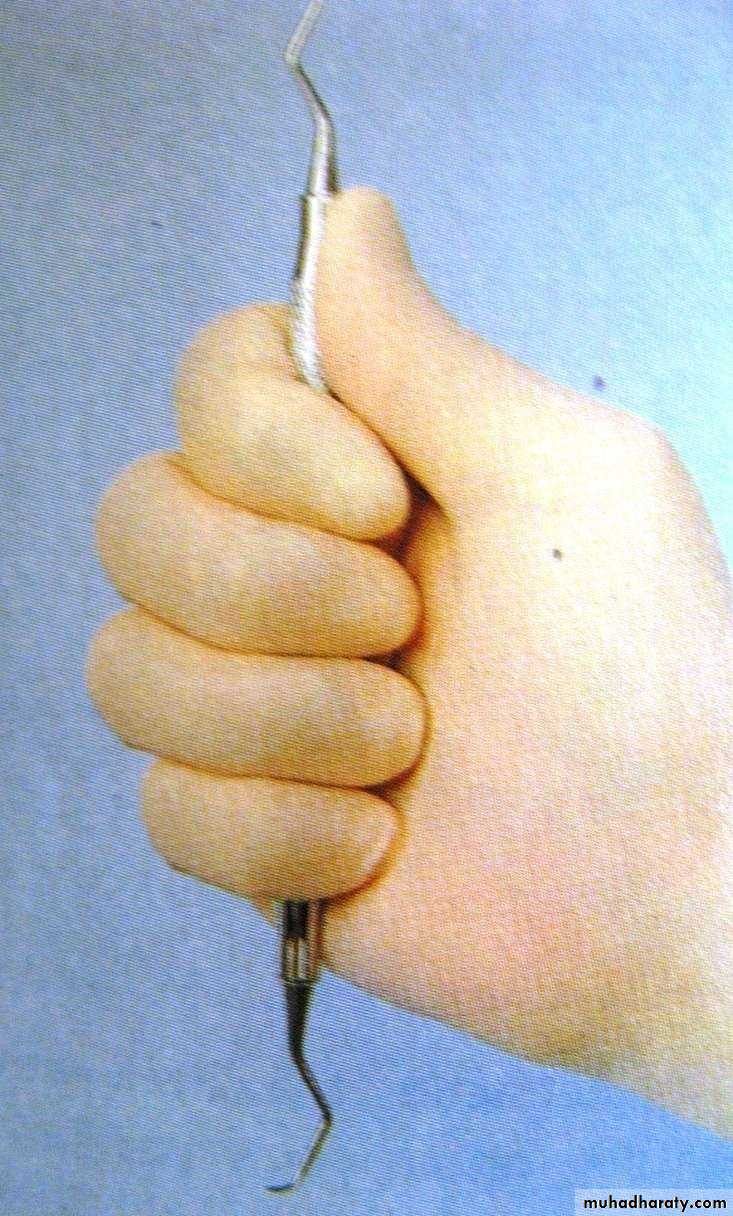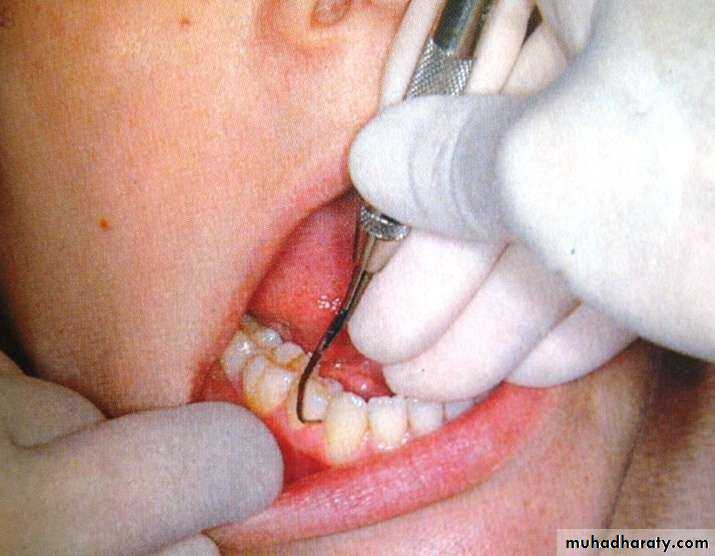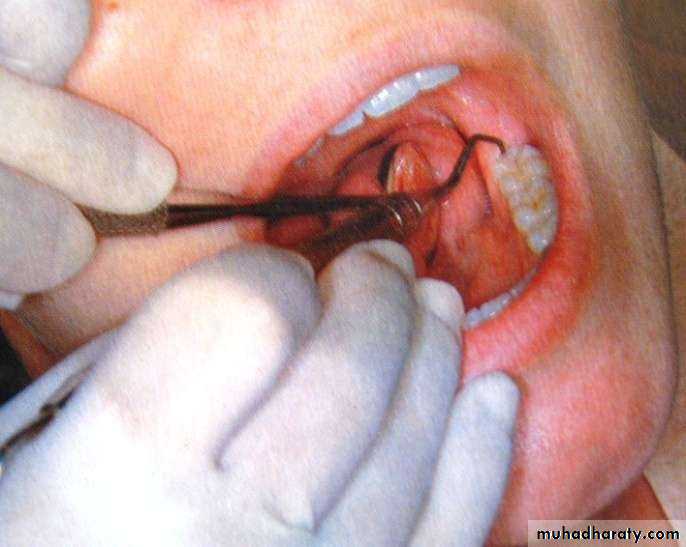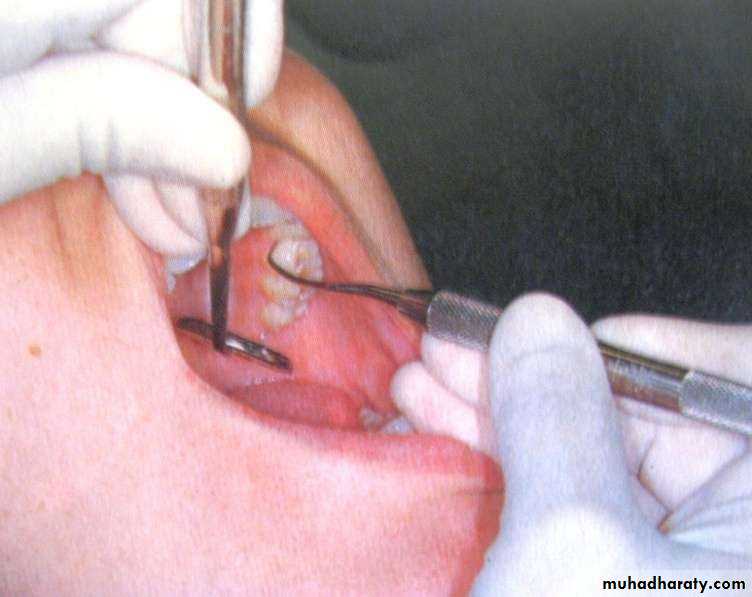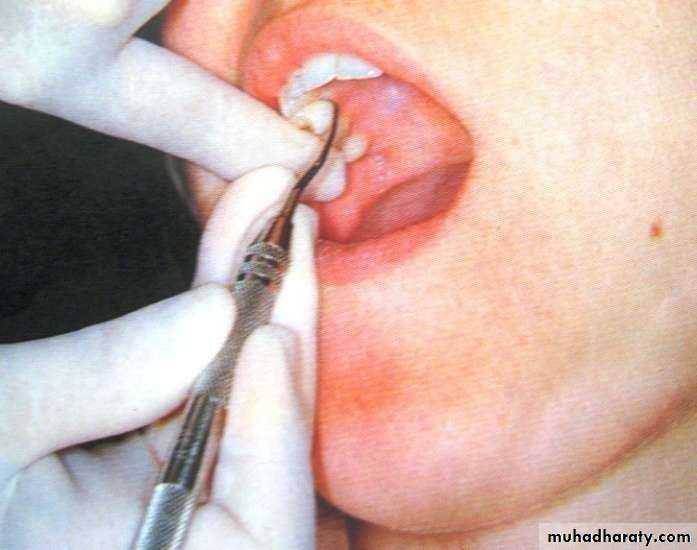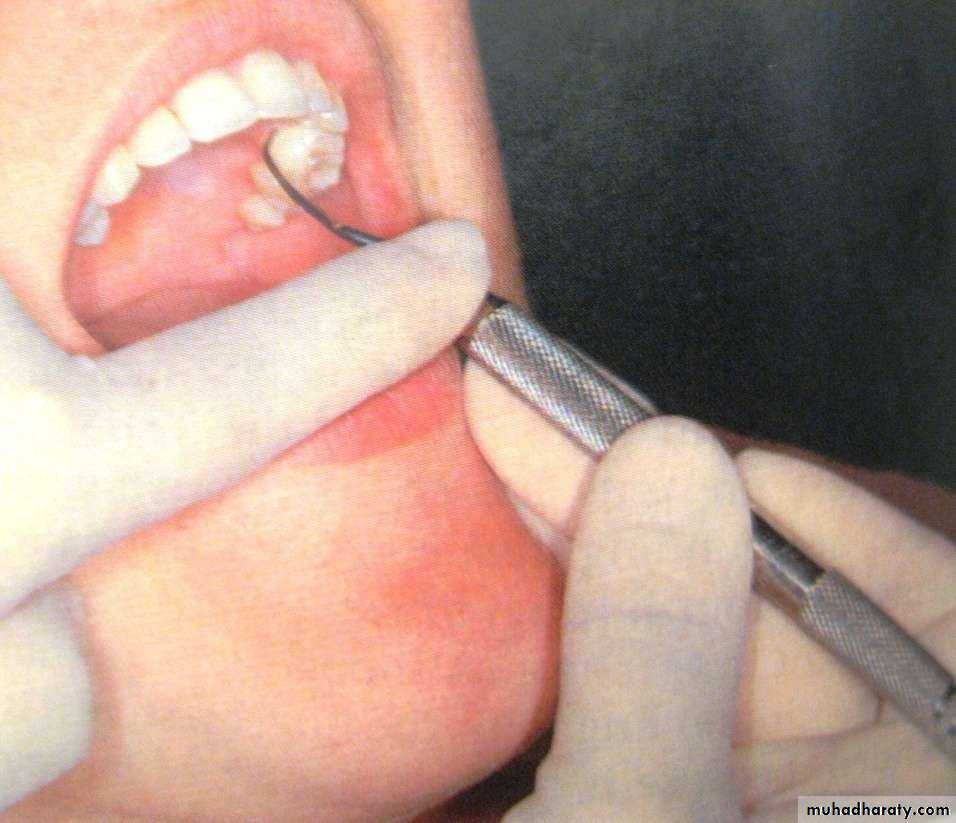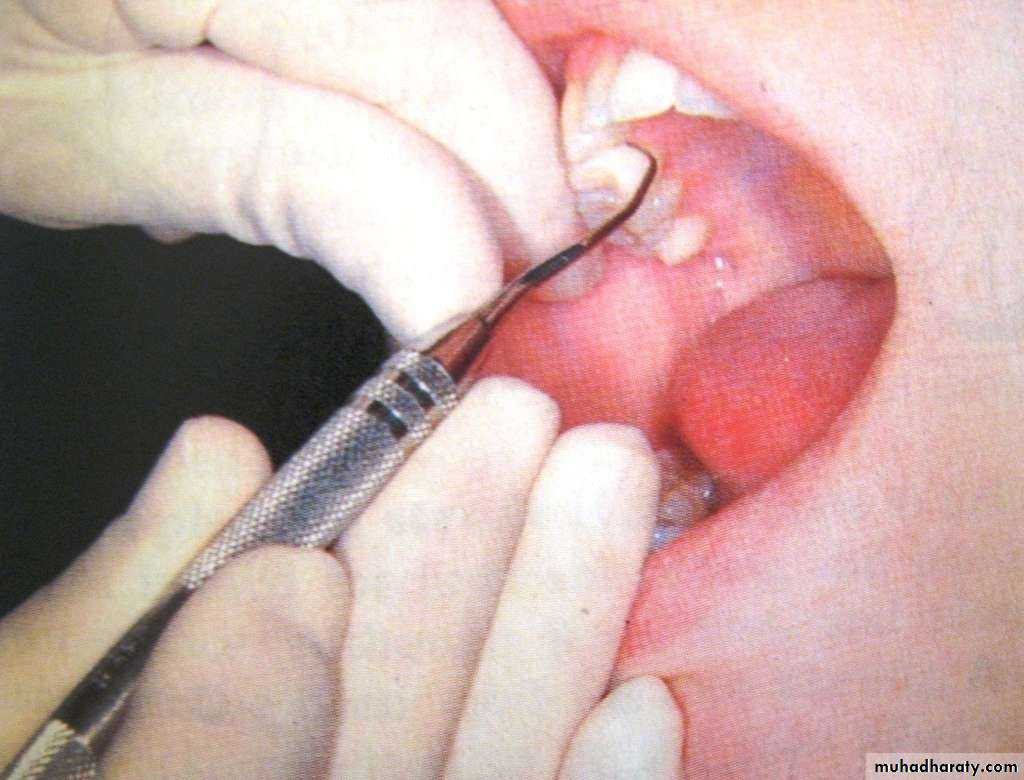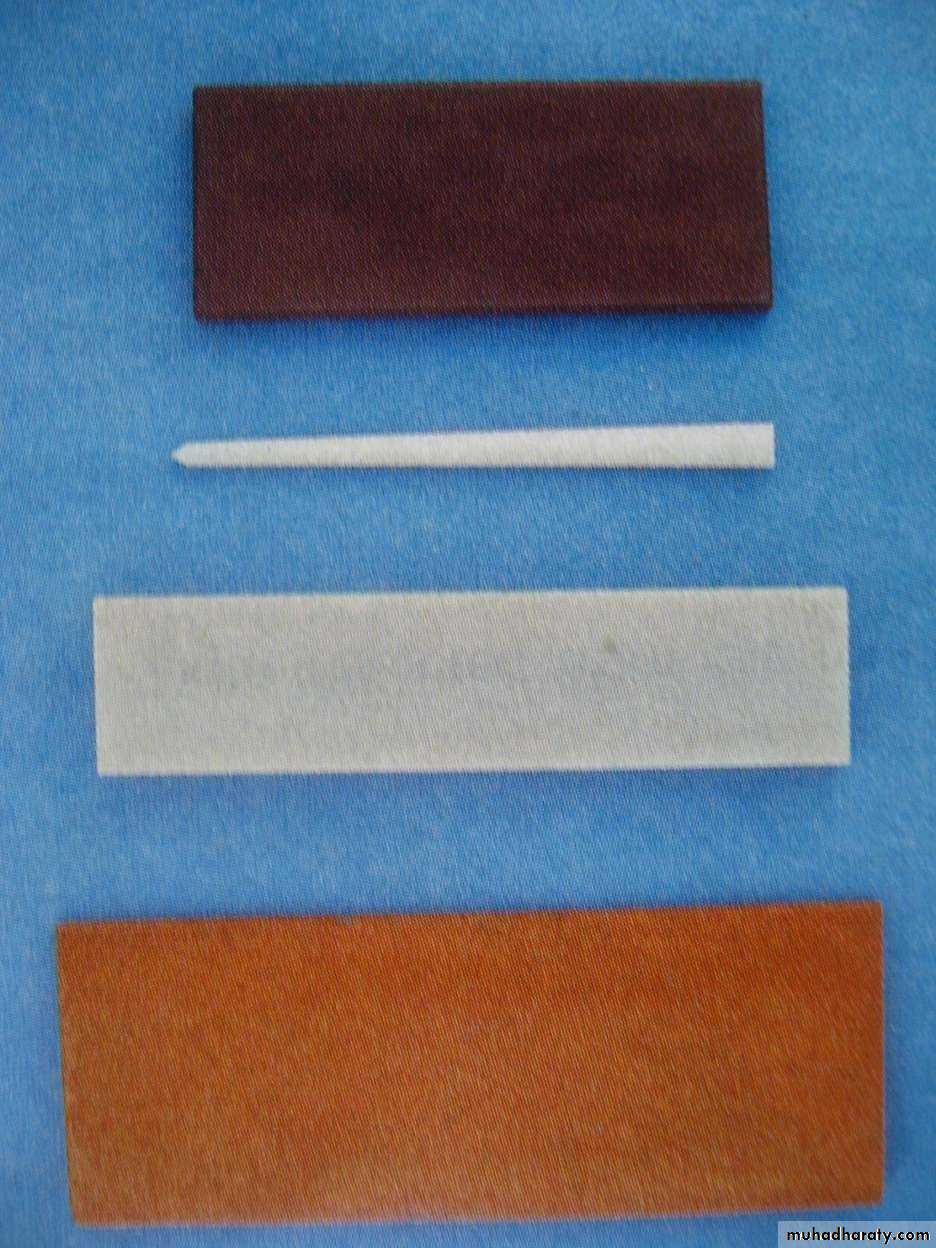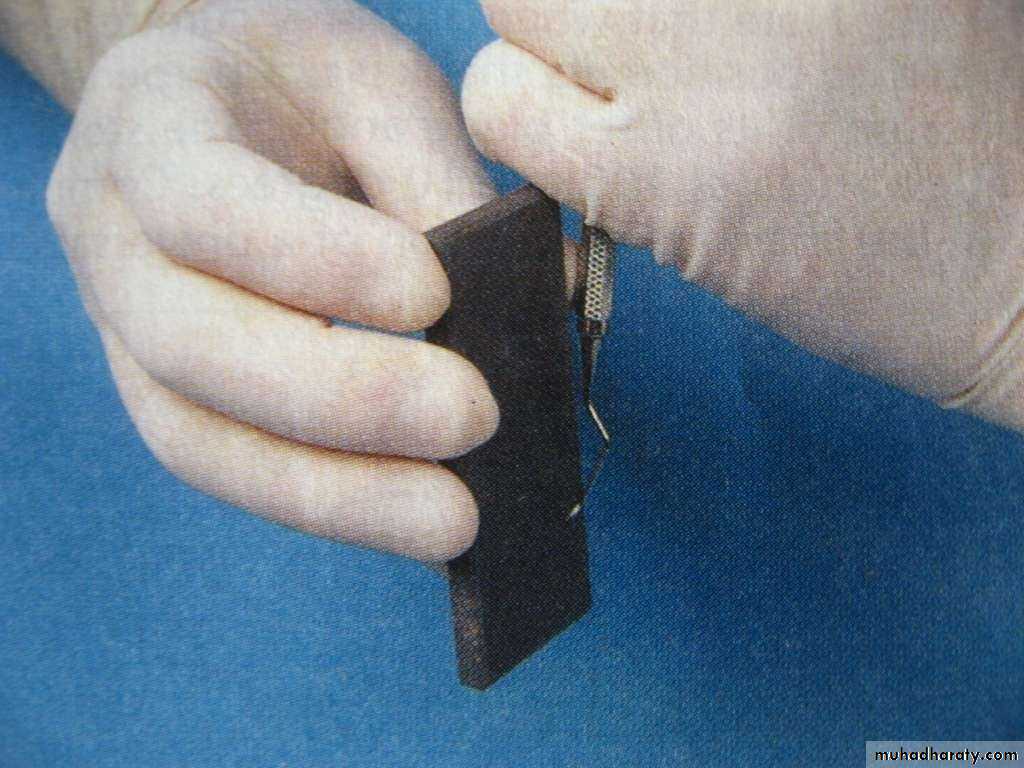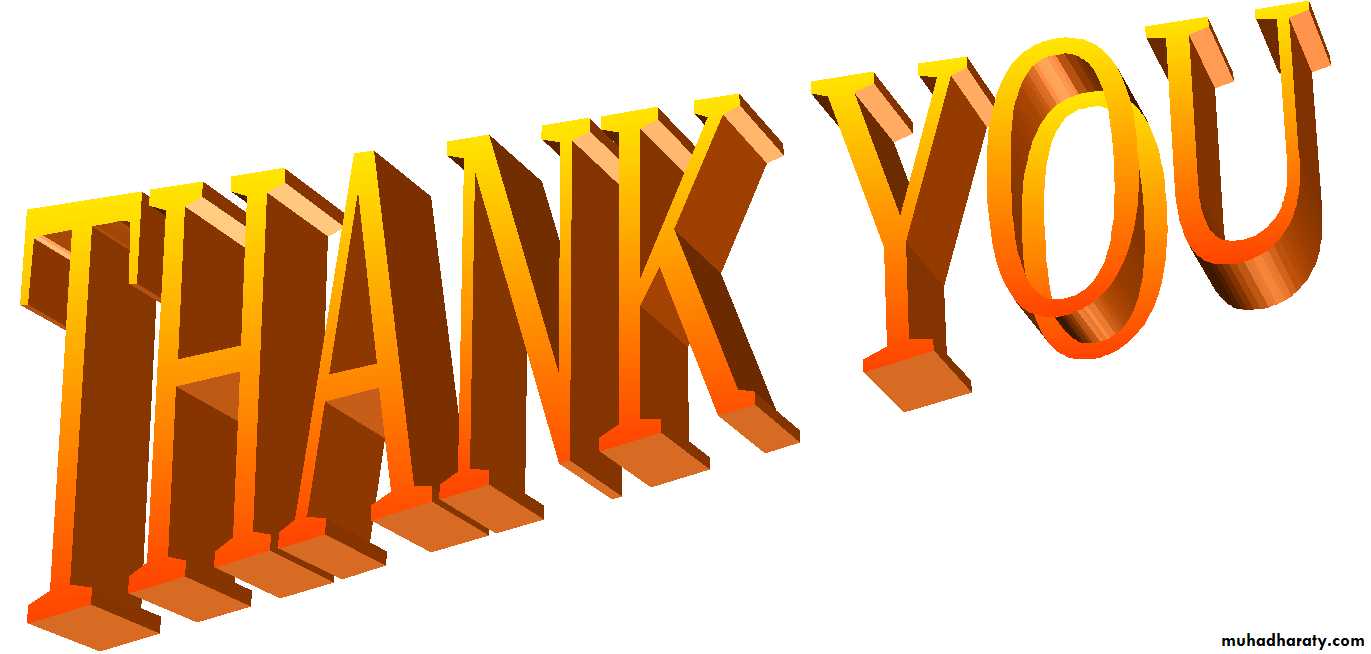• DEPT OF PERIODONTICS
• DR. Hussein AL Dabbagh•
• • Periodontal probes explorers
•
•
•
• Scaling, root-planing & curettage
• Periodontal endoscope
• Cleansing & polishing instruments
•
• PERIODONTAL PROBES-• used to locate, measure and mark pockets as well as determine their course on individual tooth surfaces
•
• EXPLORERS-
• to locate calculus deposites and caries
•
• SCALING, ROOT-PLANING AND CURETTAGE INSTRUMENTS-• for removal of plaque and calcified deposites from crown and root of tooth, removal of altered cementum from the subgingival root surface, and debridement of the soft tissue lining the pocket.
• Sickle scaler- to remove supragingival calculus
• Curettes- for subgingival scaling, root planing and removal of the soft tissue lining the pocket
• Hoe, chisel and file scaler- to remove tenacious calculus and altered cementum
• Ultrasonic and sonic instruments- for cleansing and polishing tooth surface and curetting the soft tissue wall of the periodontal pocket
•
• CLEANSING & POLISHING INSTRUMENTS-• eg: rubber cups, brushes, air-powder abrasive system
• Marquis colour coded probe
• Unc-15 probe• University of Michigan “o” probe
• Michigan “o” probe with marking 3, 6 and 8
• W.H.O. probe
• NABERS PROBE
• • Tapered rod like instrument caliberated in millimeters, with a blunt round tip
•
•
•
• Fufcation areas best evaluated by the curved blunt nabers probe
• Plastic probes in case of implants
• Probe is inserted with a firm gentle pressure to the bottom of the pocket. Shank should allign with the long axis of the tooth
•
• • Used to
• Remove large calculus deposits from the enamel surface
• Used with a pull stroke.
•
• Lateral surface:- straight, meet in a point tipNo. of cutting edge:- 2 cutting edge•
•
•
•
• Working end in cross section:- triangular
• Sickle scalers with straight shanks are designed for use on anterior teeth
• Sickle scalers with contra angled shanks adapt to posterior teeth.
•
• • Hoe scalers are used for scaling of ledges or rings calculusBlade is bent at 99 angle
•
•
•
•
• Cutting edge beveled at 45 degree blade is slight bowed so that it can
• Maintain two contact at two points on a convex surface
• The blade is inserted to the base of the peridontal pocket so that it makes two point contact with the tooth .This stablizes the instrument and prevent nicking of the root.
• The instrument is activated with a firm pull stroke toward the crown,
•
• It is designed for the proximal surface of teeth too closely spaced to permit the use of other scalers•
•
•
• It is usually used in anterior part of the mouth
• Chisel inserted from facial surface
• Instrument is activated with a push motion while the side side of the blade is held firmly against the root
•
• Their primary function is to fracture orCrush large deposite of tenacious calculus•
•
• Files can easily roughen root surfaces when used improperly therefore, they are suitable for fine scaling
•
• Short, powerful pull stroke that is used for the removal of both supragingival & subgingival calculus•
• Curettes are of two types
• Universal• Area specific
• Universal curettes:
• -Used in any area• -Both cutting edges used
• -Curved in one plane
• -Face of blade at 90 degree to shank
• Area specific:
• -Used in specific areas• -One cutting edge used
• -Curved in two plane offset blade
• GRACEY CURETTES
• 1-2 & 3-4• 5-6
• 7-8 & 9-10
• 11-12
• 13-14
• ANTERIOR TEETH ANTERIOR teeth & PREMOLARS
• Facial & lingual- posteriors
• Mesial- posteriors distal- posteriors
•
• EXTENDED SHANK CURETTES
• -Modification of gracey curettes
• -TERMINAL SHANK IS 3mm LONGER, ALLOWING EXTENSION INTO DEEPER PERIODONTAL POCKET OF 5mmor MORE
• -
•
• Schwartz periotrieversA set of double ended highly magnetized instruments designed for the retrievel of brocken instrument tips•
• Plastic instruments
• For implants to avoid scarring and permanent damage to implants
•
• Diamond COATED FILES• Unique instruments used for final finishing of root surfaces
•
• Quetin furcation curettes
• Hoes with a shallow, half moon
• Radious that fits into roof or floor of furcation & developmental depressions of root surface
•
• • Used for removing plaque, stains, for scaling & curettage2 types-magnectostrictive & piezoelectric
•
•
•
• Alternating electric currents generates oscillations that causes scaler tip to vibrate
• 20,000-45,000 cycles per sec
• In magnetostrictive, pattern of vibration is elliptical- all sides of the tip are active
• In piezoelectric, vibration is linear- two sides of tip are active
•
• Consists of a hand piece that attaches to a compressed air line.•
•
• 2000-6500 cps
• Less power for calculus removal than ultrasonic units
• MAGNETOSTRICTIVE ULTRASONIC UNIT
•
• Rubber cups:- consist of a rubber withOr without webbed configurations in the hollow interior•
•
• Used in handpiece with a special prophylaxis
• A good cleansing & polishing paste that contain flouried should be used & kept moist to minimize friction heat
•
• • Available in wheel & cup shapesUsed in prophylaxis angle with a polishing paste
• DENTAL TAPE
•
• Dental tape with polishing paste in used for polishing proximal surface
• That are inaccessible to other polishing instruments
•
• USED FOR GINGIVECTOMY•
• USED IN PERIDONTAL SURGERY•
• Needed to reflect & move the flap after the incision has ben made for flap surgery
•
• Used to hold the flap during suturing•
• Used to position & displace the flap after the flap has benn reflected
• Debakey tissue forceps
•
• Used to remove tabs of tissue duringGingivectomy, trim the margin of flap, enlarge incision in peridontal absceses ,remove muscle attachment in surgery.
GOLDMAN – FOX SCISSORS
•
• Used to suture the flap at the desire portion after surigal procedure has been complete.• CASTROVEJO NEDDLE HOLDER
•
• Accessibility: positioning of patient and operator.•
•
•
•
•
• Visibility, illumination & retraction
• Condition and sharpness of instrument
• Maintaining a clean field instrument stabilisation instrument activation
•
• Direct vision with direct illumination from dental light•
•
•
• Indirect vision by using mouth mirror
• Retraction provides visibility, acessibility & illumination
• Mirror also used for retraction cheeks or tongue
• Index finger is used for retraction of the lip
•
• Make sure that are clean, sterile & in good condition.•
•
• Sharp instruments enchance tactile sensitivity & allow the clinician to work more precisely.
• INSTRUMENT GRASP
• •
• Modified pen grasp
• standard pen grasp
• palm and thumb grasp
• FINGER REST
•
•
•
• Conventional
• cross arch
• opposite arch finger on finger
•
• PEN GRASP•
• The thumb, index finger, & middle finger are used to hold instrument as
• Pen in held
•
• MODIFIED PEN GRASP:-Ensure greatest control in performingIntraoral procedures•
• For stabilizing instruments during sharpening and for manipulating air and water syringes•
• Conventional finger rest is established on tooth surface immediately adjacent to working area•
• Cross arch finger rest is estabilished on teeth surface on the other side of the same arch•
• Opposite arch finger rest is established tooth surface on the opposite arch
•
• Finger on finger rest: is established on the index finger or thumb of the nonoperating hand.•
• For effective instrumention of some aspects of the maxillary posterior teeth•
• Palm up:- fulcrum is established by resting the backs of the middle & fourth finger on the skin overlying the lateral aspects of the mandible.
•
• The palm down fulcrumm is established by resting the front surface of the middle & fourth finger on the skin overlying the later aspect of the mandible.•
• ADAPTATION•
• Adaptation refers to the manner in which the working end of the instrument is placed against the tooth
• Angulation
• Angulation refers to the angle between the face of a bladed instrument and the tooth surface
• -Also called tooth-blade relationship
• during insertion—0
• Scaling & root planing– 45-90
•
• LATERAL PRESSURE•
• It refers to the pressure created when force is applied against the surface of the tooth with the cutting edge of a bladed instrument
• May be firm, moderate or light
• Uncontrolled application of heavy forces should be avoided
• Strokes
• 3 types -exploratory
• Scaling
• Root planing
• Any of these strokes may be activated by a pull or push motion in vertical oblique or horizontal direction
• Exploratory stroke:
• Light feeling stroke used with probes and explorers to evaluate the dimention of pocket & to detect calculus & irregularities on tooth surface.
• Scaling stroke:
• Short powerfull pull stroke used with bladed instruments for the removal of both subgingival & supragingival calculus.
• Scaling motion should be initiated in the fore arm &transmitted to the wrist to the hand with a slight flexion of fingers
• Push scaling motion is rarely used
• Root planing stroke:
• Moderate to light pull stroke used for final smoothening & planing of the root surface• Hoes, files, curettes & ultra sonic instruments can be used
• Mounted rotary stones
• Mounted on a metal mandrill cylindrical conical or disc shaped difficult to control, creates heat,
• Tends to wear the instrument
• Easily
• Unmounted stones
• Rectangular, cylindrical or cone shaped
• Either instrument stablized & stone drawn across it or stone stablized & instrument drawn across stone
• Eg INDIA STONE ARKANAS STONE CERAMIC STONE

